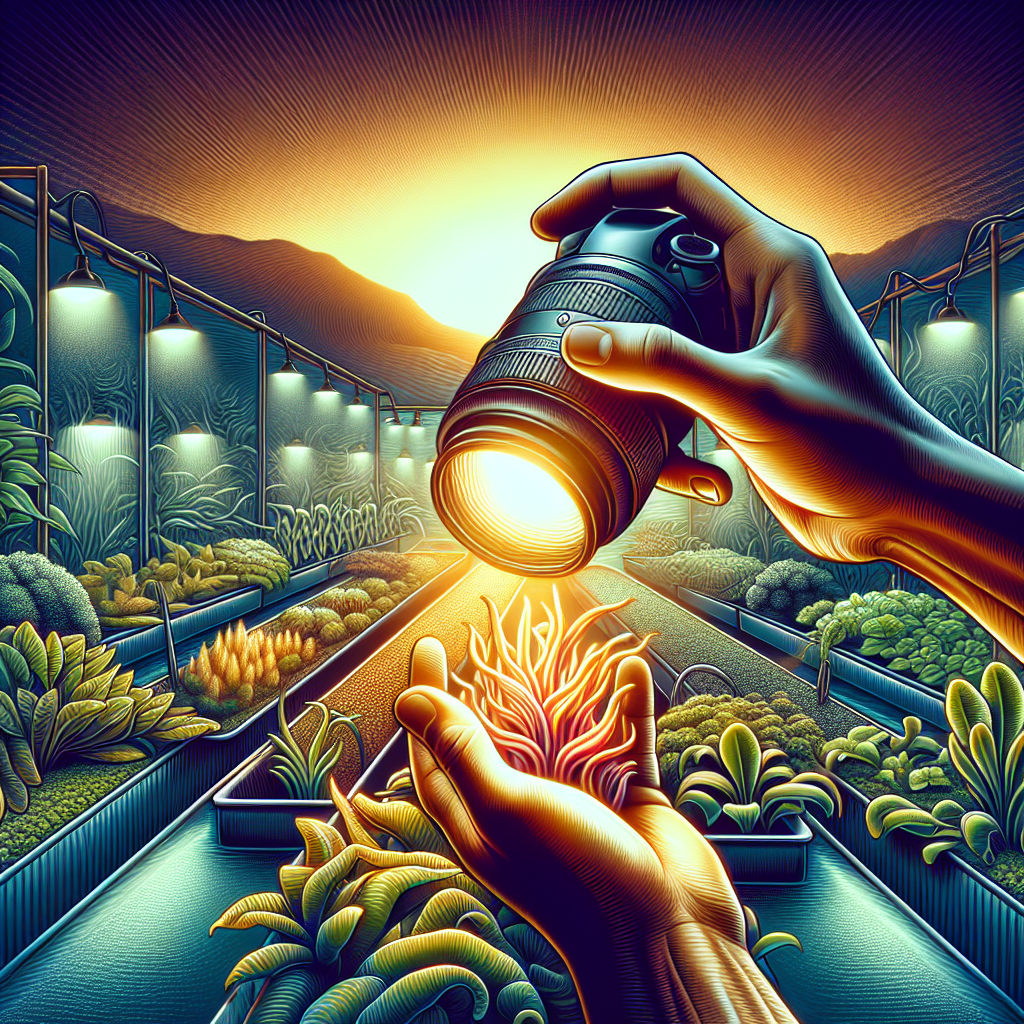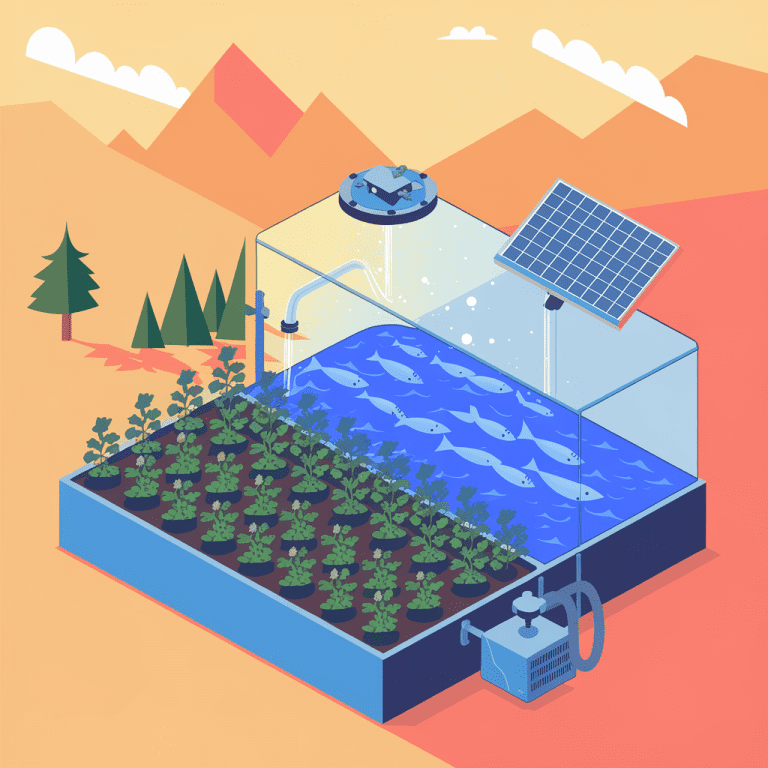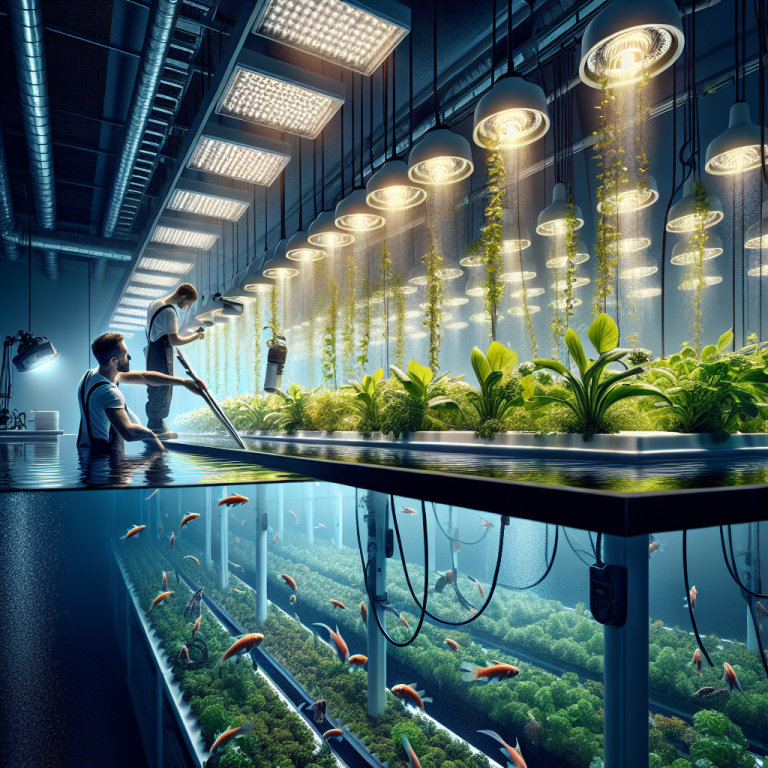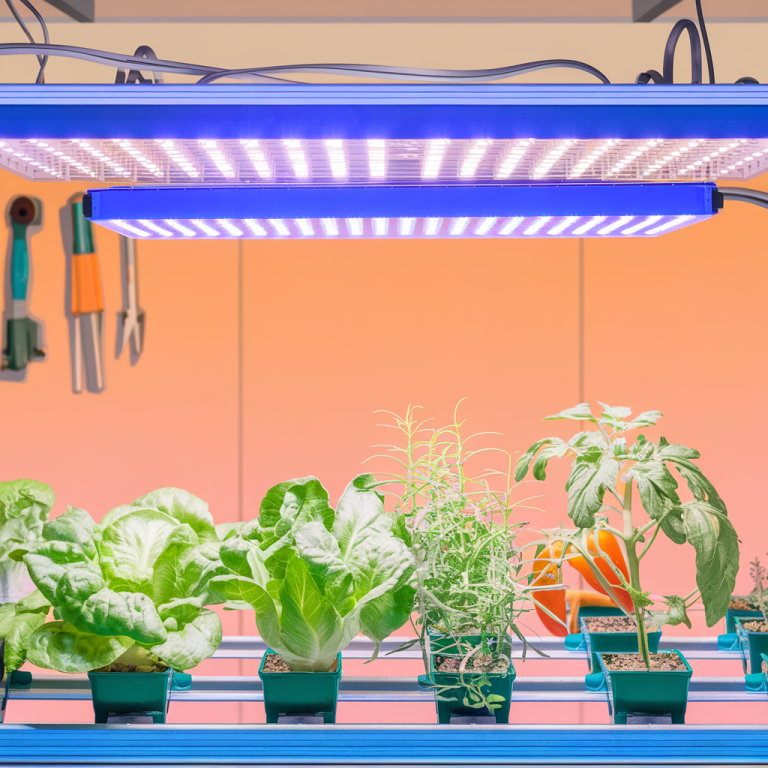Introduction to Lighting in Aquaponics
Have you ever stopped to think about the critical role that lighting plays in the success of an aquaponics system? Trust me, it’s a game-changer! Picture this: you walk into your aquaponics garden, and your plants are thriving, bursting with vibrant greenery and luscious fruits. That’s the power of proper lighting!
Lighting in aquaponics isn’t just about brightening up your plants’ day; it’s about providing them with the essential energy they need to grow and flourish. Plants rely on light for photosynthesis, a magical process where they convert light energy into chemical energy, fueling their growth and development. It’s like giving your plants a daily dose of sunshine, even on the cloudiest days.
Now, let’s dive into a fascinating fact about lighting in aquaponics. Did you know that different types of plants have varying light requirements? Just like us, plants have their preferences when it comes to lighting. Some thrive under bright, direct light, while others prefer a bit of shade. Understanding your plants’ lighting needs is key to creating the perfect environment for them to thrive.
One practical tip I always emphasize is to pay attention to the light spectrum when choosing your lighting setup. Plants respond differently to various colors of light, with red and blue light being crucial for photosynthesis. By selecting the right light spectrum for your plants, you can supercharge their growth and boost your harvests.
So, here’s a question to ponder: How can you optimize your aquaponics lighting setup to cater to the specific needs of your plants? It’s like solving a puzzle where each plant has its unique requirements. By fine-tuning your lighting strategy and customizing it to suit your plants’ preferences, you’ll create an oasis of growth and abundance in your aquaponics garden.
As we continue our journey into the world of aquaponics lighting, remember that the light you provide isn’t just illumination; it’s the life force that fuels your plants’ journey from seed to harvest. Stay tuned for more insights and tips on mastering the art of lighting in aquaponics. Your plants will thank you with a bountiful harvest!
Importance of Proper Lighting for Plant Growth
Have you ever stopped to think about how crucial lighting is for the flourishing growth of plants in aquaponics systems? Imagine walking into a room filled with vibrant greenery, all thriving under the perfect balance of light. It’s truly a mesmerizing sight to behold.
Let me share a fascinating fact with you – did you know that different plants require specific light spectrums to photosynthesize effectively? Yes, it’s like each plant has its own unique light preferences, just like we have our favorite foods! Understanding this concept can significantly impact the success of your aquaponics setup.
Picture this: you’re nurturing a variety of herbs and vegetables in your aquaponics garden, each with its own distinct lighting needs. By selecting the right lighting options tailored to the specific requirements of your plants, you’re essentially creating a personalized environment for them to thrive.
Now, let’s delve deeper into the world of lighting in aquaponics. Think of lighting as the main source of energy for your plants, much like how sunlight fuels our bodies. By providing your plants with the optimal lighting conditions, you’re essentially fueling their growth and ensuring they reach their full potential.
Consider this – have you ever tried to read a book in a dimly lit room? It’s challenging, right? Plants face a similar struggle when they don’t receive adequate light. They may become leggy, weak, and struggle to produce fruits or flowers. By understanding the importance of proper lighting and implementing the right strategies, you’re setting your plants up for success.
As we continue our journey into the realm of lighting in aquaponics, remember that each plant has its own unique needs and preferences when it comes to light. By paying attention to these nuances and adjusting your lighting setup accordingly, you’ll witness a remarkable transformation in your aquaponics garden. Stay tuned for more insights on how to illuminate your plants’ path to prosperity!
Types of Lighting Options for Aquaponics Systems
As we dive into the world of lighting options for aquaponics systems, it’s essential to understand the different types available and how they can impact your plants’ growth. Picture this – you walk into a garden bathed in the warm glow of sunlight, witnessing the magic of photosynthesis at work.
Imagine replicating this natural phenomenon indoors with the use of artificial lighting. Did you know that different light sources emit varying spectrums of light, each influencing plant growth in unique ways? From fluorescent to LED to high-intensity discharge (HID) lights, the options can seem overwhelming at first glance.
Let’s shed some light on the matter (pun intended) by exploring the benefits and drawbacks of each lighting type. Whether you’re a beginner or a seasoned aquaponics enthusiast, selecting the right lighting is crucial for the success of your system.
Consider this practical tip: LED lights are energy-efficient and emit specific wavelengths that cater to plant growth stages. This not only saves on electricity costs but also provides optimal conditions for your plants to thrive.
Now, ponder this thought-provoking question – how can we harness the power of light to maximize the potential of our aquaponics setup? By understanding the intricacies of light spectrum and duration, we can create an environment tailor-made for plant prosperity.
Intrigued by the endless possibilities that lighting offers in aquaponics? Stay tuned as we delve deeper into the world of artificial illumination and its transformative effects on plant cultivation. Remember, the right light can illuminate not just your plants but also your path to a bountiful harvest.
Understanding Light Spectrum in Aquaponics
Light spectrum in aquaponics may sound like a complex topic, but trust me, it’s fascinating once you dive in. Picture this: each color of light plays a crucial role in the growth and development of your plants. Isn’t that amazing?
Now, let’s take a closer look. Have you ever wondered why plants appear green to us? Well, here’s an interesting tidbit for you: plants reflect green light, which is why they look green. But when it comes to their growth, plants primarily absorb red and blue light for photosynthesis. This is where understanding light spectrum becomes crucial in optimizing your aquaponics system.
Imagine your plants as little energy connoisseurs, eagerly soaking up the specific wavelengths of light they need to thrive. By providing the right balance of red, blue, and even a touch of green light, you’re essentially catering to their energy preferences, just like offering a buffet of their favorite foods. It’s all about creating the perfect ambiance for your plants to flourish.
As you navigate the world of aquaponics lighting, remember that finding the ideal light spectrum is akin to finding the perfect recipe for plant success. It’s like being a plant DJ, mixing different light wavelengths to create a harmonious blend that sets the stage for robust growth.
So, here’s a thought to ponder: How can you fine-tune your aquaponics lighting setup to give your plants the VIP treatment they deserve? Consider the dance of colors and wavelengths in your system, and watch as your plants respond with vibrant health and bountiful yields. It’s a symphony of light and growth waiting to unfold in your very own aquaponics oasis.
Setting Up Lighting for Maximum Plant Health
When it comes to setting up lighting for your aquaponics system, it’s crucial to understand the impact different light spectrums can have on plant growth. Imagine walking into a room where plants are thriving under a colorful array of lights, each hue playing a specific role in nurturing their development.
Light spectrum refers to the range of colors emitted by a light source, each with its own unique wavelength and energy level. In the world of aquaponics, this diversity of light plays a critical role in photosynthesis, the process by which plants convert light energy into chemical energy to fuel their growth.
Consider how plants respond to different colors of light – red and blue wavelengths are essential for photosynthesis, with red light promoting flowering and fruiting, while blue light facilitates vegetative growth. It’s like giving your plants a customized light diet tailored to their specific needs!
By strategically selecting lighting options that offer the right balance of red, blue, and other wavelengths, you can create an environment that optimizes plant growth and productivity. Picture your aquaponics setup as a vibrant ecosystem where light acts as the nurturing force driving your plants to flourish.
Just like a chef carefully selects ingredients to create a masterpiece dish, choosing the right light spectrum for your aquaponics system can elevate your plants to their full potential. It’s all about harnessing the power of light to cultivate a thriving environment where your plants can thrive and produce bountiful harvests.
So, the next time you’re setting up your aquaponics system, think about the spectrum of light you’re providing – it’s not just about brightness, but about the unique qualities of each color that influence the health and growth of your plants. Embrace the beauty of light spectrum diversity and watch your aquaponics garden come alive with vitality and abundance!
Tips for Choosing the Right Lighting for Aquaponics
Lighting plays a crucial role in the success of your aquaponics system. When it comes to choosing the right lighting for your plants, there are a few key factors to consider. One practical tip to keep in mind is to match the light spectrum with the specific needs of your plants.
Different plants have varying light requirements depending on their growth stage. For example, leafy greens thrive under blue spectrum light, while flowering plants benefit more from red spectrum light. Understanding these nuances can make a significant difference in the health and productivity of your aquaponics garden.
Imagine your aquaponics system as a symphony orchestra, with each plant playing a unique instrument. Just as a conductor ensures that each musician has the right music sheet, you need to provide the appropriate lighting for each plant variety to flourish.
By tailoring the light spectrum to match the needs of your plants, you are essentially composing a harmonious melody in your aquaponics garden. This approach not only optimizes plant growth but also enhances the overall visual appeal of your setup.
Consider this: Did you know that some plants can actually perceive different colors of light and adjust their growth patterns accordingly? It’s like giving your plants their own personal light show, with each color signaling a specific cue for growth and development.
So, the next time you’re setting up your aquaponics lighting, think of yourself as a lighting designer for a botanical performance. Choose the right spectrum to create a mesmerizing visual display and ensure that each plant gets its moment in the spotlight. After all, in the world of aquaponics, the right lighting can truly make your plants sing.
Duration of Lighting for Different Plant Stages
When it comes to aquaponics, getting the lighting just right is essential for the health and growth of your plants. You might be wondering, how long should I leave the lights on for? Well, the duration of lighting plays a crucial role in ensuring your plants thrive in the aquaponics system.
Finding the optimal lighting duration can be a bit of a balancing act. Too much light can lead to algae growth and stress the plants, while too little light can hinder photosynthesis and result in stunted growth. It’s like Goldilocks finding that “just right” balance – not too much, not too little, but the perfect amount.
So, how do you determine the right lighting duration for your aquaponics setup? One practical tip is to consider the specific needs of the plants you are growing. Different plants have different light requirements based on their growth stage and species. For example, leafy greens like lettuce may thrive with around 12-14 hours of light per day, while fruiting plants like tomatoes might benefit from 14-16 hours of light.
Another factor to consider is the intensity of the light. Higher light intensity may allow for shorter durations, while lower light intensity may require longer exposure. It’s all about creating the ideal environment for your plants to photosynthesize effectively and grow to their full potential.
By understanding the relationship between lighting duration, intensity, and plant needs, you can fine-tune your aquaponics system to provide the perfect lighting conditions. Experiment with different durations, observe how your plants respond, and adjust as needed to optimize their growth. Remember, when it comes to lighting in aquaponics, striking that balance is key to nurturing a flourishing ecosystem.
Common Lighting Mistakes to Avoid in Aquaponics
Have you ever found yourself scratching your head over why your aquaponics plants aren’t thriving as expected, only to realize that the culprit may be improper lighting? It’s a common mistake that many aquaponics enthusiasts make, but fear not – I’m here to shed some light on the subject (pun intended).
In the world of aquaponics, lighting plays a crucial role in the growth and development of your plants. But it’s not just a matter of turning on a light and calling it a day. There are nuances to consider, such as the intensity and duration of light exposure, as well as the specific light spectrum that your plants require.
Let’s dive into the realm of lighting in aquaponics and explore some common mistakes that you’d want to avoid. One prevalent error is overlooking the importance of providing the right amount of light for your plants. Too much light can lead to scorched leaves and stunted growth, while too little light can result in leggy plants and poor yields.
Another misstep that many aquaponics beginners make is using the wrong type of lighting for their setup. Different plants have varying light requirements, so it’s essential to choose the appropriate lighting fixtures that can meet the specific needs of your crops.
To ensure optimal plant growth and health in your aquaponics system, it’s crucial to strike a balance between providing adequate light without overdoing it. Consider factors such as the natural light available in your growing space, the lighting schedule that mimics daylight hours, and the importance of monitoring your plants’ response to the light provided.
By avoiding these common lighting mistakes and implementing the right strategies, you can set your aquaponics system up for success and enjoy a bountiful harvest of fresh, healthy produce. So, let’s brighten up your aquaponics journey by illuminating the path to vibrant plant growth!
DIY Lighting Solutions for Aquaponics Enthusiasts
Have you ever considered creating your own DIY lighting solution for your aquaponics system? It’s a fun and rewarding project that can truly enhance the growth of your plants. Imagine the satisfaction of watching your plants thrive under the customized lighting you’ve designed yourself.
When it comes to DIY lighting in aquaponics, the possibilities are endless. You can experiment with different types of LED lights, adjust the light spectrum to meet the specific needs of your plants, and even incorporate smart lighting controls to automate the process. The best part is that you don’t need to be an expert in electronics or engineering to get started – there are plenty of resources and tutorials available online to guide you through the process.
One practical tip to keep in mind when creating your DIY lighting solution is to ensure that your setup is adjustable. Plants have varying light requirements at different stages of growth, so having the flexibility to adjust the intensity and duration of light exposure is crucial for their development. By customizing your lighting setup to suit the specific needs of your plants, you can provide them with the optimal conditions for thriving in your aquaponics system.
As you embark on this DIY lighting journey, consider the broader implications of the impact your customized lighting solution can have on the overall success of your aquaponics system. Not only will you be enhancing the growth and health of your plants, but you’ll also be cultivating a deeper connection with your garden through the creative process of building and optimizing your own lighting setup.
So, why not roll up your sleeves, gather your supplies, and dive into the exciting world of DIY lighting in aquaponics? The possibilities are endless, and the rewards are truly bountiful.
Conclusion and Final Thoughts on Lighting in Aquaponics
Have you ever stopped to consider the crucial role that lighting plays in the fascinating world of aquaponics? As an expert in the field, I am thrilled to delve into this topic with you today. Picture this: a lush aquaponics system brimming with vibrant plants and thriving fish, all basking in the gentle glow of strategically placed lights. It’s a sight to behold, isn’t it?
Let’s explore the magical relationship between lighting and aquaponics. Beyond simply illuminating your system, light is the lifeblood that fuels plant growth and sustains the delicate balance of your aquatic ecosystem. Just like us, plants have their preferences when it comes to lighting. From the intensity and duration of light exposure to the specific wavelengths that trigger optimal growth, every aspect must be carefully considered to ensure your plants flourish.
Now, here’s a fascinating tidbit for you: did you know that different plant species have unique light requirements? Some plants thrive under bright, direct light, while others prefer a more subdued ambiance. Understanding these nuances is the key to creating an environment where every plant can reach its full potential. It’s like orchestrating a symphony of light and life within your aquaponics system.
As you navigate the world of aquaponics lighting, consider this practical tip: experiment and observe. Pay close attention to how your plants respond to different lighting setups. Are they reaching for the sky, or are they showing signs of stress? By tinkering with light intensity, duration, and spectrum, you can fine-tune your setup to meet the specific needs of your plants.
So, dear reader, I leave you with a question to ponder: How can you harness the power of light to create a thriving oasis in your aquaponics system? Embrace the art and science of lighting, and watch as your plants dance to the rhythm of nature’s spotlight. Let’s illuminate the path to aquaponic success together!




